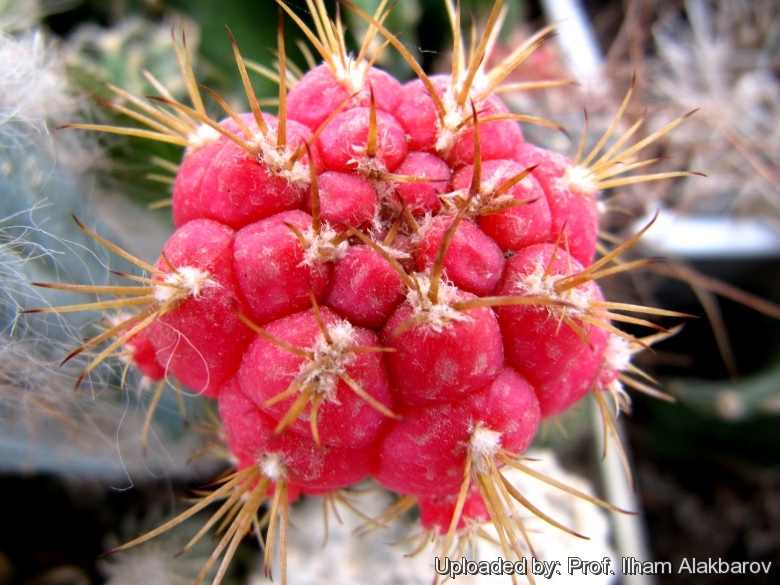Accepted Scientific Name: Gymnocalycium eurypleurum F.Ritter
Kakteen Südamerika 1: 268, fig. 1979

Gymnocalycium eurypleurum f. rubra Photo by: Prof. Ilham Alakbarov
Origin and Habitat: Garden origin (Nursery produced cultivar)
Synonyms:
See all synonyms of Gymnocalycium eurypleurum
Description: Gymnocalycium eurypleurumSN|21445]]SN|21445]] is a variable low growing species especially for spination. (Some plants have minimal spination while others seem quite heavily armed)
Forma rubra (red form): The red schizochromic form (Gymnocalycium eurypleurumSN|21445]]SN|21445]] f. rubra) has bright orange-red to purple stems due to the absence (or reduced production) of chlorophyll pigments: every other pigment is present at normal levels, the dominant green colouration is lost, but will still more than likely have normal other pigments that give the yellow overall appearance of the stem. This form with red stems is very attractive and highly prized. This schizochromic form is almost always seen grafted on stronger columnar species, and cannot can be grown on its own roots. However some clones have enough chlorophyll in their tissues and can be grown on they own roots too, but very slow growing.
Habit: Usually grows solitarily.
Stem: Bright orange-red to deep purple, flattish globular (mature plants may become slightly short columnar) 7-15(-20) cm across, with a somewhat sunken apex.
Ribs: Usually 7-12 (up to 16), very flat and broad, with scarcely evident protuberances and often a small horizontal indention above the areoles.
Areoles: Covered by some tomentum.
Spines: Stout, awl shaped, glassy white to light-brown in clusters of about 7 mostly straight up to10-30(-60) mm in length, very symetrical, and tending to curve upwards, away from the body of the cactus. no obvious central spine. The 1 or 2 central spines - when one exists - have the same length.
Flowers: Mostly near the apex, bell-shaped, pure white or white with a hint of lilac, about 30 mm in length and diameter. Inner petals are white to light pink, outer petals are a light purple colour with a dark purple centre strip. Filaments and style are white. Anthers creamy-white to pale yellow.
Blooming season: Flowers freely throughout the Summer.
Fruits: Round or barrel shaped.
Subspecies, varieties, forms and cultivars of plants belonging to the Gymnocalycium eurypleurum group
Bibliography: Major references and further lectures
1) Edward Anderson “The Cactus family” Timber Press, Incorporated, 2001
2) James Cullen, Sabina G. Knees, H. Suzanne Cubey "The European Garden Flora Flowering Plants: A Manual for the Identification of Plants Cultivated in Europe, Both Out-of-Doors and Under Glass" Cambridge University Press, 11/Aug/2011
3) David R Hunt; Nigel P Taylor; Graham Charles; International Cactaceae Systematics Group. "The New Cactus Lexicon" dh books, 2006
4) Demaio, P., Kiesling, R., Pin, A. & Oakley, L. 2013. Gymnocalycium eurypleurum. In: IUCN 2013. "IUCN Red List of Threatened Species." Version 2013.2. <www.iucnredlist.org>. Downloaded on 18 February 2014.
Cultivation and Propagation: Variegated and albinous cacti are regarded as choice and difficult in cultivation, but despite that many of them are relatively easy to grow. But be aware that they cannot tolerate prolonged exposure to direct sun light (especially during the hottest summer days), so grow them in half-shade or under filtered sun. They are sometime seen as grafted plants, but many grow well on their own roots, too.
On the contrary, the albinos can survive only if grafted on a strong green base.
Use mineral well-permeable substratum with little organic matter (peat, humus). Water sparingly from March till October and keep perfectly dry in winter at temperatures from 5 to 15 degrees centigrade. (In general these plants are more tender and cannot endure freezing temperatures ) In the rest period no high atmospheric humidity!!
Propagation: Usually by seed. Plants are often grafted onto column-shaped cacti.










